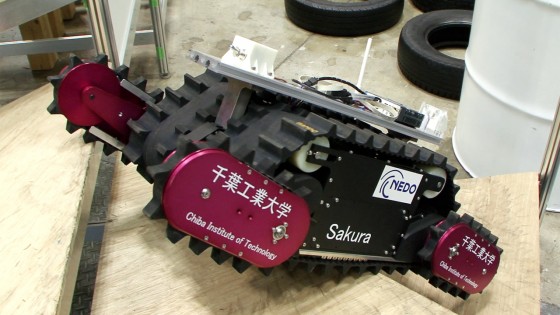
Robohub.org
Disaster response robot will inspect the damaged Fukushima nuclear reactor building

This compact explorer robot, called Sakura, being developed by the Future Robotics Technology Center (fuRo) at the Chiba Institute of Technology, is the latest in their line of disaster response robots, and has been designed so it can enter and survey the basements of the damaged Fukushima nuclear reactor buildings.
“Sakura’s mission is to go into the underground levels of nuclear power plants. It’s very compact, as it has to go down stairways just 70 cm wide, and turn around on landings that are also 70 cm.”
“Coolant water is leaking from somewhere inside the reactor, because no matter how water much is pumped in, the level doesn’t stay above 60 cm. But unless that space can be filled with water, the melted-down fuel rods can’t be removed safely. So, Sakura’s first job is to find out where the cracks are.”
Sakura will use its camera to look for cracks, but as the camera can’t see everywhere, Sakura also has a directional microphone to detect the sound of water.
An additional obstacle is that the stairway below ground is steeper than that above. So, Sakura also has improved climbing performance to handle steep gradients.
“The part above ground slopes at 40 degrees, and that below ground at 42 degrees. This difference of just two degrees is very hard for a robot to handle. What’s more, Sakura has to climb down, and then climb up, to the top of the suppression pool. That stairway slopes at 53 degrees.”
To minimize the operator’s exposure to radiation, Sakura has an automatic extension and retraction device for communication cables, and a plug-in charging system. Sakura is also made from specially selected materials, with the aim of making it maintenance-free for three years.
“To make the robot radiation-hard, the previous model, Rosemary, has a 2mm aluminum plate on the bottom, but Sakura has a 5mm stainless steel plate. Radiation is expected to be high in the underground areas, so the bottom surface is designed to provide at least some shielding.”
“We’ve only just got Sakura to move, so for the next month, we’ll be testing its mobility and durability. Once that’s done, we’ll test its ability to carry the necessary equipment on a stairway. Then, we plan to fine-tune Sakura by testing it with TEPCO.”
tags: Fukushima, Japan




